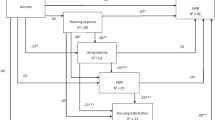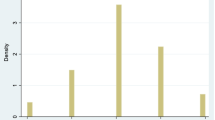Abstract
Living in inadequate housing conditions not only supposes a failure of a basic functioning. It also has effects on other essential aspects of well-being such as health. This study questions to what extent living in poor housing conditions can determine individuals’ health status once the possible influence of other factors is controlled for. By estimating a logistic model with individual effects and a housing deprivation index based on a latent variable model, we reach a number of relevant conclusions concerning the relationship between these two different dimensions of multidimensional well-being. We find a negative effect of housing deprivation on the individuals’ health, both when housing conditions are introduced in a disaggregated manner in the model and when they are combined in a latent variable.
Similar content being viewed by others
References
Albanese MT, Knott M (1990) TWOMISS: A computer program for fitting a one -or two- factor logit-probit latent variable model to binary data when observations may be missing. Technical Report, Statistics Department, London School of Economics and Political Science
Auster R, Leveson I, Sarachek D (1969) The production of health, an exploratory study. J Hum Resour 4: 411–436
Ayala L, Navarro C (2007) The dynamics of housing deprivation. J Hous Econ 16: 72–97
Baltagi BH (2001) Econometric analysis of panel data. Wiley, Chichester
Bartholomew DJ, Knott M (1999) Latent variable models & factor analysis. Kendall’s library of statistics, vol 7. Oxford University Press, New York
Becker GS (1965) A theory of the allocation of time. Econ J 75: 493–517
Bock RD, Aitkin M (1981) Marginal maximum likelihood estimation of item parameters: application of an EM algorithm. Appl Psychol Meas 37: 29–51
Bolin K, Jacobsson L, Lindgren B (2001) The family as health producer-the case when family members are Nash-Bargainers. J Health Econ 20: 349–362
Bolin K, Jacobsson L, Lindgren B (2002a) Employer investments in employee health. Implications for the family as health producer. J Health Econ 21: 563–583
Bolin K, Jacobsson L, Lindgren B (2002) The family as health producer—when spouses act strategically. J Health Econ 21: 475–495
Borg V, Kristensen T (2000) Social class and self-rated health: can the gradient be explained by differences in lifestyle or work environment?. Soc Sci Med 51: 1019–1030
British Medical Association Board of Science and Education (2003) Housing and health: building for the future. British Medical Association, UK
Burstrom B, Fredlund P (2001) Self-rated health: is it a good predictor of subsequent mortality among adults in lower as well as in higher social classes?. Epidemiol Community Health 55: 836–840
Chiappero EA (2000) Multidimensional assessment of well-being based on Sen’s functioning approach. Rivista Internazionale di Scienze Sociali 2: 207–239
Contoyannis P, Jones AM (2004) Socioeconomic status, health and lifestyle. J Health Econ 23: 965–995
Dale A, Williams M, Dodgeon B (1996) Housing deprivation and social change: a report based on the analysis of individual level census data for 1971, 1981 and 1991 drawn from the Longitudinal study and the Samples of anonymised records. Office For National Statistics, Series LS No. 8. HMSO, London
Department of Health (1998) Green paper: our healthier nation. The Stationery Office, London
Department of Health (1999) White paper: our healthier nation. The Stationery Office, London
Dunn JR (2000) Housing and health inequalities: review and prospects for research. Housing Stud 15: 341–366
Grossman M (1972a) On the concept of health capital and the demand for health. J Polit Econ 80: 223–255
Grossman M (1972b) The demand for health: a theoretical and empirical investigation. Occasional Paper National Bureau of Economic Research 119
Grossman M (1999) The human capital model of the demand of health. NBER Working Paper 7078
Hsiao C (1985) Benefits and limitations of panel data. Econc Rev 4: 121–174
Ineichein B (1993) Homes and health. E & FN Spon, London
Jacobson L (2000) The family as a producer of health–an extended grossman model. J Health Econ 19: 611–637
Kemna H (1987) Working conditions and the relationship between schooling and health. J Health Econ 6: 189–210
Kenkel DS (1995) Should you eat breakfast? Estimates from health production functions. Health Econ 4: 15–29
Knott M, Tzamourani P (1997) Fitting a latent trait model for missing observations to racial prejudice data. In: Rost J, Langeheine R (eds) Applications of latent trait and latent class models in the social sciences. Waxmann, Münster
Krieger J, Higgins DL (2002) Housing and health: time again for public health action. Am J Public Health 92: 758–768
Kunst AE, Geurts J, Van Den Berg J (1995) International variation in socioeconomic inequalities in self-reported health. J Epidemiol Commun Health 49: 117–123
Lowry S (1991) Housing and health. BMJ, London
Manning W, Newhouse JP, Ware JE (1981) The status of health in demand estimation; or, beyond excellent, good, fair, poor. In: Fuchs V (eds) Economic aspects of health. University of Chicago Press, Chicago
Marcoulides GA, Moustaki I (eds) (2002) Latent variable and latent structure models. Lawrence Earlbaum Publishers, NJ
Marsh A, Gordon D, Heslop P, Pantazis C (2000) Housing deprivation and health: a longitudinal analysis. Hous Stud 15: 411–428
Matyas L, Sevestre P (eds) (1992) The econometrics of panel data. Kluwer Academic Publishers, The Netherlands
Ministry of Social Development and Economic Security (2001) Homelessness-causes & effects: the cost of homelessness in British Columbia. British Columbia Ministry of Social Development and Economic Security and BC Housing Management Commission, vol 3, Toronto
Moisio P (2004) Latent class application to the multidimensional measurement of poverty. Qual Quant 38: 703–717
Moustaki I, Knott M (2000) Weighting for Item non-response in attitude scales using latent variable models with covariates. J Roy Stat Soc (Ser A) 163: 445–459
Navarro C, Ayala L (2008) Multidimensional housing deprivation indices with application to Spain. Appl Econ 40: 597–611
Navarro C et al (2002) Privación en vivienda y estado de salud: una estimación para el caso español. In: Cabases JM (eds) La organización territorial de la sanidad. Universidad Pública de Navarra, Asociación de Economía de la Salud, Navarra, pp 377–404
Power C, Hertzman C (1997) Social and biological pathways linking early life and adult disease. In: Marmot M, Wadsworth M (eds) Fetal and early childhood environment: long-term health implications, vol 53. British Medical Bulletin, pp 210–23
Rosenzweig M, Schultz TP (1983) Estimating a household production function: heterogeneity, the demand for health inputs, and their effects on birth weight. J Polit Econ 91: 723–746
Silber J (2007) Measuring poverty: taking a multidimensional perspective. FEDEA Working Papers 2007-14
Smith SJ (1989) Housing and health: a review and research agenda. Discussion Paper 27, Centre for Housing Research, Glasgow University
Taubman P, Rosen S (1981) Healthiness, education and marital status. In: Fuchs V (eds) Economic aspects of health. University of Chicago Press, Chicago
Van Doorslaer E, Wagstaff A, Bleichrodt H, Calonge S, Gerdtham U-G, Gerfin M, Geurts J, Gross L, Hakkinen U, Leu RE (1997) Income-related inequalities in health: some international comparisons. J Health Econ 16: 93–112
Wagstaff A, Van Doorslaer E, Paci P (1989) Equity in the finance and delivery of health care: some tentative cross-country comparisons. Oxford Rev Econ Policy 5: 89–112
Author information
Authors and Affiliations
Corresponding author
Rights and permissions
About this article
Cite this article
Navarro, C., Ayala, L. & Labeaga, J.M. Housing deprivation and health status: evidence from Spain. Empir Econ 38, 555–582 (2010). https://doi.org/10.1007/s00181-009-0279-5
Received:
Accepted:
Published:
Issue Date:
DOI: https://doi.org/10.1007/s00181-009-0279-5




